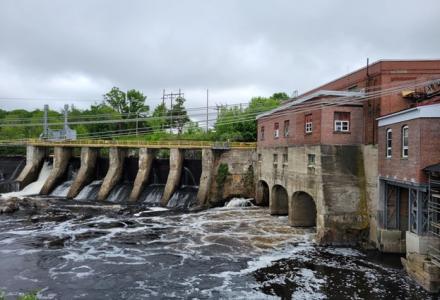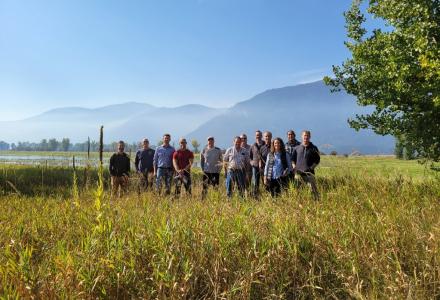
Lake sturgeon are one of the most iconic species of the Great Lakes. The massive fish can live as long as 55-150 years along the bottom of the lakes, tributaries and rivers in the system, gobbling up snails, crayfish, mussels and insects. Once they are adults, they begin looking for suitable spawning habitat. But what are they looking for?
“It’s primarily three major characteristics: flow, substrate and water temperature,” said Justin Chiotti, a fish biologist with the US Fish and Wildlife Service. Both Western and Indigenous knowledge contribute to scientists’ understanding of the timing of, and changes to, these key factors affecting sturgeon reproduction.
These ancient fish were once abundant across the Great Lakes, spawning in all the major rivers and tributaries. In the late 1800s, they were heavily overfished. Along with pollution and a loss of habitat, sturgeon numbers fell to 1 percent of historic levels by 1950.
There has been an intensive effort to help the fish recover, though it’s been a slow process since they only reach maturity after about 20 years. According to the IJC’s 16th Biennial Report on Great Lakes Water Quality, young sturgeon are sensitive to low oxygen levels and contaminants in water.
Water Temperature and Flows
Chiotti, who works on sturgeon habitat restoration projects in the St. Clair and Detroit River system alongside his Canadian counterparts, said water temperature is the cue for sturgeon to begin looking for places to spawn.
The exact range is hard to pin down. He said Western research has found they’ll spawn when temperatures are anywhere between about 10-18 degrees Celsius (50-64 degrees Fahrenheit). But the colder of that scale is typically when the bulk of the species will go looking for rivers with suitable flow, depth and substrate. Generally, this happens in May or early June, Chiotti said.
There is some variability to water temperatures year-to-year, said Richard Drouin, lead management biologist for Lake Erie with the Ontario Ministry of Northern Development, Mines, Natural Resources and Forestry. In colder, icier years spawning may be delayed, and vice versa in warmer years. Water needs to be warm enough for young sturgeon to hatch and begin growing in a healthy way, he explained.
Sturgeon also look for high water flows between 0.5-1.3 meters per second (1.6-4.2 feet per second), Drouin said. This tends to introduce ample oxygen for the eggs and larval fish, and help the young hatchlings move downstream into areas they can begin feeding after they’ve hatched. Drouin added there are knowledge gaps for this period of the sturgeon lifecycle, but young sturgeon seem to find a specific area they like and stay around there until they grow big enough to begin swimming around the larger Great Lakes system.
Indicators, Substrate and Climate
Traditional Ecological Knowledge, or TEK, that Indigenous communities around the region have collected over millennia also speaks to the timing of sturgeon spawning.
From 2011 through 2015, the IJC’s Rainy-Lake of the Woods Watershed Board worked with the Seine River First Nation on a project regarding lake sturgeon using the Seine River to spawn, west of Lake Superior.
Elders within that community explained as part of the study that people traditionally used the appearance of the tiger swallowtail (or yellow monarch) butterfly, the size of poplar leaves and the timing of nighttime salamander calls as indicators for when sturgeon would begin their spawning runs. These TEK indicators or signals lined up well with environmental indicators used in the board’s study, Chiotti said, which in turn sync up with criteria most Western science agencies look for.
When it comes to spawning, substrate has been a major limiting factor for decades.
Sturgeon like large cobble reefs to lay their eggs in, as these provide safe places for the eggs and newly hatched fish to avoid predators. Human development through the 1800s and 1900s limited access to suitable reefs, notably through dam construction in tributaries and rivers. In some cases, such as the Lakes Huron-Erie corridor, cobble reefs were destroyed to make way for shipping channels and infrastructure. Even with the right water flows and temperatures, sturgeon won’t spawn unless they find the right reefs.
Some reefs did remain intact, including one near the Bluewater Bridge in the St. Clair River, Chiotti said. Others were built over the past 20 years as scientists learn more about what sturgeon like. In the Detroit River, for example, there are reefs on the Canadian side off Fighting Island, and on the US side off Belle Isle. As long as a reef is deep enough or out of the way of shipping, there are no issues for sturgeon or people, he said.
Drouin said restoration and preservation work is being done in many Great Lakes tributaries to learn more about what habitat sturgeon like and look for in those environments, as well as what limiting factors exist. Notably, there seems to be a population in eastern Lake Erie near the upper Niagara River that may be worth targeting for future restoration efforts.
“Our partners have been doing similar studies using radio telemetry and fish tagging to better understand that population and how it’s moving around the area,” Drouin said.
For water depth, Drouin said there are indications that sturgeon prefer water to be around 5-10 meters (16-32 feet) deep for spawning. For restoration work, it has been important to ensure that reefs are deep enough that the sturgeon will avoid shipping traffic.
Chiotti said there is still an open question on how climate change may impact lake sturgeon in the Great Lakes. The lakes have always had annual variability owing to their size, he said. A 2014 study in the Journal of Applied Ichthyology found that lake sturgeon do best in cool water conditions during the summer, but that some rivers and tributaries to the Great Lakes are unlikely to offer safe spawning habitat in the future if water temperatures continue to rise.
The State of the Great Lakes 2019 report by Canadian and US agencies notes that while sturgeon populations are still far removed from their historical numbers, each of the Great Lakes is sustaining remnant populations that can range from several thousand to tens of thousands of individual fish. While there are a few self-sustaining populations across the lakes, government and nongovernmental agencies continue to stock juveniles into the rivers and tributaries entering the lakes to ensure that sturgeon can continue to recover.

Kevin Bunch is a writer-communications specialist at the IJC’s US Section office in Washington, D.C.




